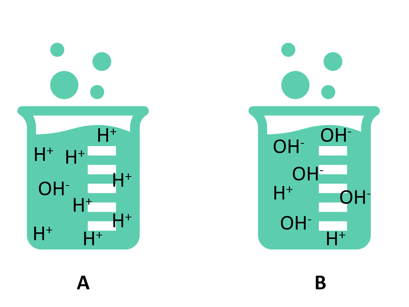What Are Acids and Bases- Chemistry Class X- Winspire Magazine

What Are Acids and Bases?
There are many ways of defining acids and bases. While these definitions do not contradict each other, they do vary in how inclusive they are. The most commonly accepted definitions of the acids and bases are Lewis acids and bases. Brønsted-Lowry acids and bases, and Arrhenius acids and bases. Justus Liebig, Humphry Davy, and Antoine Lavoisier also made observations regarding acids and bases but didn’t formalize definitions.
Svante Arrhenius Acids and Bases.
The Arrhenius theory of acids and bases dates back to 1884, building on his observation that salts, such as sodium chloride, dissociate into what he termed ions when placed into water.
- acids produce H+ ions in aqueous solutions
- bases produce OH- ions in aqueous solutions
- water required, so only allows for aqueous solutions
- only protic acids are allowed; needed to produce the hydrogen ions
- only hydroxide bases are allowed.
Johannes Nicolaus Brønsted – Thomas Martin Lowry Acids and Bases.
Brønsted-Lowry or Brønsted theory explains acid-base reactions as an acid releasing the proton and a base accepting the proton. While the acid definition is somewhat the same as that, which was proposed by Arrhenius (hydrogen ion is a proton), the definition of what constitutes a base is much broader.
- bases are proton acceptors.
- acids are proton donors.
- only protic acids are allowed.
- bases besides hydroxides are permissible.
- aqueous solutions are permissible.
Gilbert Newton Lewis Acids and Bases.
The Lewis theory of acids and bases is the least restrictive model. It does not deal with protons at all but deals with the electron pairs.
- acids are electron-pair acceptors.
- bases are electron-pair donors.
- least restrictive of the acid-base definitions
Properties of Acids and Bases.
Robert Boyle explained the qualities of acids and bases in the year 1661. These characteristics may be used to easily distinguish between the two sets up chemicals without performing complicated tests:
Acids
- taste sour (don’t taste them!)—the word ‘acid’ comes from the Latin acere, which means ‘sour.’
- acids are corrosive.
- acids change litmus paper (a blue vegetable dye) from blue to red
- their aqueous (water) solutions conduct electric current (are electrolytes)
- react with bases to form salts and water
- evolve hydrogen gas (H2) upon reaction with an active metal (such as alkali metals, alkaline earth metals, zinc, aluminium)
Common Acids
- the citric acid (from certain fruits and veggies, notably citrus fruits like lemon and orange)
- lactic acid (in buttermilk)
- vinegar (5% acetic acid)
- ascorbic acid (vitamin C, as from certain fruits)
- carbonic acid (for carbonation of soft drinks).
Bases
- taste bitter (don’t taste them!)
- bases don’t change the colour of litmus; they can turn red (acidified) litmus back to blue
- feel slippery or soapy (don’t arbitrarily touch them!)
- react with acids to form salts and water
- their aqueous (water) solutions conduct an electric current (are electrolytes)
Common Bases
- soap.
- detergents.
- household ammonia (aqueous).
- lye (NaOH).
Strong and Weak Acids and Bases.
The strength of an acid or a base depends on their ability to break into their ions or dissociate into water. A strong acid or a strong base completely dissociates (e.g., HCl or NaOH), on the other hand, a weak acid or weak base partially dissociates (e.g., acetic acid).
The acid dissociation constant and base dissociation constant indicates the relative strength of an acid or a base. The acid dissociation constant Ka is the equilibrium constant of an acid-base dissociation:
HA + H2O ⇆ A- + H3O+
where HA is the acid and A- is the conjugate base.
Ka = [A-][H3O+] / [HA][H2O]
This is used to calculate pKa, the logarithmic constant:
PKA = – log10 Ka
The larger the pKa value, the smaller the dissociation of the acid and the weaker the acid. Strong acids have a pKa of less than -2.
We’ve created this content for informational purposes only, and it reflects the views of its respective authors/entities (freelancers/interns) and not those of Winspire Magazine. Winspire Magazine does not endorse or vouch for the accuracy of the information provided in this content. It is the reader’s responsibility to verify and ensure the information is correct and up-to-date. Winspire Magazine disclaims any liability or responsibility for any damages or losses from using this content. Therefore, readers should take all necessary steps to verify the accuracy and reliability of any information presented in this content.


